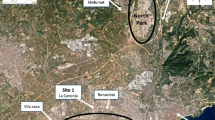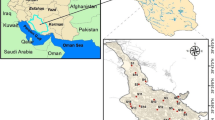Abstract
Thirteen particle-phase PAHs, including nine >4-ring congeners [Benz[a]anthracene (BaAn), Chrysene (Chry), Benzo[b]fluoranthene (BbF), Benzo[k]fluoranthene (BkF), Benzo[e]pyrene (BeP), Benzo[a]pyrene (BaP), Dibenzo[a,h]anthracene (dBaAn), Benzo[g,h,i]perylene (BghiPe), Indeno(1,2,3-c,d)pyrene (IP)], listed by IARC (International Agency for Research on Cancer) as class 1, class 2A, and 2B carcinogens, plus four ≤4-ring congeners [Phenanthrene (Ph), Anthracene (An), Fluoranthene (Fl), Pyrene (Py)], were concurrently measured in inhalable and respirable particle fractions (PM10 and PM2.5) at a heavy-traffic and an urban background site in Thessaloniki, northern Greece, during the warm and the cold period of the year. Carcinogenic and mutagenic potencies of the PAH-bearing particles were calculated, and the inhalation cancer risk (ICR) for local population was estimated. Finally, Chemical Mass Balance (CMB) modeling was employed for the source apportionment of ambient PAH levels and the estimated lung cancer risk. Resulted inhalation cancer risk during winter was found to be equivalent in the city center and the urban background area suggesting that residential wood burning may offset the benefits from minor traffic emissions.







Similar content being viewed by others
References
Alghamdi MA, Alam MS, Yin J, Stark C, Jang E, Harrison RM, Shamy M, Mamdouh I, Khoder MI, Shabbaj I (2015) Receptor modelling study of polycyclic aromatic hydrocarbons in Jeddah, Saudi Arabia. Sci Total Environ 506–507:401–408
Argyropoulos G, Samara C (2010) Development and application of a robotic chemical mass model for source apportionment of atmospheric particulate matter. Environ Model Softw 26:469–481
Bari MA, Baumbach G, Kuch B, Scheffknecht G (2010) Particle-phase concentrations of polycyclic aromatic hydrocarbons in ambient air of rural residential areas in southern Germany. Air Qual Atmos Health 3:103–116
Bari MA, Baumbach G, Brodbeck J, Struschka M, Kuch B, Dreher W, Scheffknecht G (2011a) Characterisation of particulates and carcinogenic polycyclic aromatic hydrocarbons in wintertime wood-fired heating in residential areas. Atmos Environ 45:7627–7634
Bari MA, Baumbach G, Kuch B, Scheffknecht G (2011b) Air pollution in residential areas from wood-fired heating. Aerosol Air Qual Res 11:749–757
Belis CA, Cancelinha J, Duane M, Forcina V, Pedroni V, Passarella R, Tanet G, Douglas K, Piazzalunga A, Bolzacchini E, Sangiorgi G, Perrone M-G, Ferrero L, Fermo P, Larsen BR (2011) Sources for PM air pollution in the Po Plain, Italy: I. Critical comparison of methods for estimating biomass burning contributions to benzo(a)pyrene. Atmos Environ 45(39):7266–7275
Belis CA, Larsen BR, Amato F, El Haddad I, Favez O, Harrison RM, Hopke PK, Nava S, Paatero P, Prevot A, Quass U, Vecchi R, Viana M (2014) European guide on air pollution source apportionment with receptor models, Report EUR 26080 EN, European Commission, Joint Research Centre, Institute for Environment and sustainability
Bortey-Sam N, Ikenaka Y, Akoto O, Nakayama SMM, Yohannes YB, Baidoo E, Mizukawa H, Ishizuka M (2015) Levels, potential sources and human health risk of polycyclic aromatic hydrocarbons (PAHs) in particulate matter (PM10) in Kumasi, Ghana. Environ Sci Pollut Res 22:9658–9667
Castro D, Slezakova K, Oliva-Teles MT, Delerue-Matos C, Conceicao Alvim-Ferraz M, Morais S, Carmo Pereira M (2009) Analysis of polycyclic aromatic hydrocarbons in atmospheric particulate samples by microwave-assisted extraction and liquid chromatography. J Sep Sci 32:501–510
Chrysikou LP, Samara CA (2009) Seasonal variation of the size distribution of urban particulate matter and associated organic pollutants in the ambient air. Atmos Environ 43(30):4557–4569
Chrysikou LP, Gemenetzis PG, Samara CA (2009) Wintertime size distribution of polycyclic aromatic hydrocarbons (PAHs), polychlorinated biphenyls (PCBs) and organochlorine pesticides (OCPs) in the urban environment: street- vs. rooftop-level measurements. Atmos Environ 43(2):290–300
De Pieri S, Arruti A, Huremovic J, Sulejmanovic J, Selovic A, Ðorđević D, Fernández-Olmo I, Gambaro A (2014) PAHs in the urban air of Sarajevo: levels, sources, day/night variation, and human inhalation risk. Environ Monit Assess 186:1409–1419
Durant J, Busby W, Lafleur A, Penman B, Crespi C (1996) Human cell mutagenicity of oxygenated, nitrated and unsubstituted polycyclic aromatic hydrocarbons associated with urban aerosols. Mutat Res/Genet Toxicol 371:123–157
Dvorská A, Komprdova K, Lammel G, Klánová J, Placha H (2012) Polycyclic aromatic hydrocarbons in background air in central Europe—seasonal levels and limitations for source apportionment. Atmos Environ 46:147–154
EC (2005) Directive 2004/7/EC of the European Parliament and of the Counsil of 15 December 2004 relating to arsenic, cadmium, mercury, nickel and polycyclic aromatic hydrocarbons in ambient air. Off J Eur Commun L23/3
El Haddad I, Marchand N, Wortham H, Piot C, Besombes J-L, Cozic J, Chauvel C, Armengaud A, Robin D, Jaffrezo J-L (2011) Primary sources of PM2.5 organic aerosol in an industrial Mediterranean city, Marseille. Atmos Chem Phys 11:2039–2058
Gianelle V, Colombi C, Caserini S, Ozgen S, Galante S, Marongiu A, Lanzani G (2013) Benzo(a)pyrene air concentrations and emission inventory in Lombardy region, Italy. Atmos Pollut Res 4:257–266
Gilli G, Pignata C, Schilirò T, Bono R, La Rosa A, Traversi D (2007) The mutagenic hazards of environmental PM2.5 in Turin. Environ Res 103:168–175
Hays MD, Smith ND, Kinsey J, Dong Y, Kariher PH (2003) Polycyclic aromatic hydrocarbon size distributions in aerosols from appliances of residential wood combustion as measured by direct thermal desorption-GC/MS. J Aerosol Sci 34:1061–1084
IARC, International Agency for Research on Cancer (2010) Some non-heterocyclic polycyclic aromatic hydrocarbons and some related exposures. IARC Monogr Eval Carcinog Risks Hum 92:1–853
IARC, International Agency for Research on Cancer (2012) Agents classified by the IARC monographs. In: List of classifications by alphabetical order, http://monographs.iarc.fr/ENG/Classification/ClassificationsAlphaOrder
Jang E, Alam MS, Harrison RM (2013) Source apportionment of polycyclic aromatic hydrocarbons in urban air using positive matrix factorization and spatial distribution analysis. Atmos Environ 79:271–285
Junninen H, Mønster J, Rey M, Cancelinha J, Douglas K, Duane M et al (2009) Quantifying the impact of residential heating on the urban air quality in a typical european coal combustion region. Environ Sci Technol 43:7964–7970
Kathikeyan S, Balasubramanian R, Wei See S (2006) Optimization and validation of a low temperature microwave-assisted extraction method for analysis of polycyclic aromatic hydrocarbons in airborne particulate matter. Talanta 69:79–86
Kleeman MJ, Robert MA, Riddle SG, Fine PM, Hays MD, Schauer JJ, Hannigan MP (2008) Size distribution of trace organic species emitted from biomass combustion and meat charbroiling. Atmos Environ 42:3059–3075
Lorenzi D, Entwistle JA, Cave M, Dean JR (2011) Determination of polycyclic aromatic hydrocarbons in urban street dust: implications for human health. Chemosphere 83:970–977
Malcolm HM, Dobson S (1994) The calculation of an Environmental Assessment Level (EAL) for atmospheric PAHs using relative potencies. HMIP-Commissioned Research, Department of the Environment, London
Manoli E, Voutsa D, Samara C (2002) Chemical characterization and source identification/apportionment of fine and coarse air particles in Thessaloniki, Greece. Atmos Environ 36:949–961
Manoli E, Kouras A, Samara C (2004) Profile analysis of ambient and source emitted particle-bound polycyclic aromatic hydrocarbons from three sites in northern Greece. Chemosphere 56:867–878
Manoli E, Kouras A, Samara C (2011) Polycyclic aromatic hydrocarbons in the Greek atmospheric environment. MESAEP, 6th International Symposium on Environmental Pollution and its Impact on Life in the Mediterranean Region, Ioannina, Greece, 24–27 September 2011
Mantis J, Chaloulakou A, Samara C (2005) PM10-bound polycyclic aromatic hydrocarbons (PAHs) in the Greater Area of Athens, Greece. Chemosphere 59:593–604
Marchand N, Besombes J-L, Chevron N, Masclet P, Aymoz G, Jaffrezo JL (2004) Polycyclic aromatic hydrocarbons (PAHs) in the atmospheres of two French alpine valleys: sources and temporal patterns. Atmos Chem Phys 4:1167–1181
Martellini T, Giannoni M, Lepri L, Katsoyiannis A, Cincinelli A (2012) One year intensive PM2.5 bound polycyclic aromatic hydrocarbons monitoring in the area of Tuscany, Italy. Concentrations, source understanding and implications. Environ Pollut 164:252–258
Martuzevicius D, Kliucininkas L, Prasauskas T, Krugly E, Kauneliene V, Strandberg B (2011) Resuspension of particulate matter and PAHs from street dust. Atmos Environ 45:310–317
Masiol M, Hofer A, Squizzato S, Piazza R, Rampazzo G, Pavoni B (2012) Carcinogenic and mutagenic risk associated to airborne particle-phase polycyclic aromatic hydrocarbons: a source apportionment. Atmos Environ 60:375–382
Masiol M, Formenton G, Pasqualetto P, Pavoni B (2013) Seasonal trends and spatial variations of PM10-bounded polycyclic aromatic hydrocarbons in Veneto Region, Northeast Italy. Atmos Environ 79:811–821
Nisbet C, LaGoy P (1992) Toxic equivalency factors (TEFs) for polycyclic aromatic hydrocarbons (PAHs). Regul Toxicol Pharmacol 16:290–300
Perrone MG, Larsen BR, Ferrero L, Sangiorgi G, De Gennaro G, Udisti R, Zangrando R, Gambaro A, Bolzacchini E (2012) Sources of high PM2.5 concentrations in Milan, Northern Italy: molecular marker data and CMB modeling. Sci Total Environ 414:343–355
Petrakakis MJ, Kelessis AG, Tzoumaka PN, Samara C (2013) Levels of suspended particulate matter before and after the economic crisis in Thessaloniki Greece. 17th International MESAEP Symposium Istanbul/Turkey, September 28 to October 1, 2013
Pietrogrande MC, Abbaszade G, Schnelle-Kreis J, Bacco D, Mercuriali M, Zimmermann R (2011) Seasonal variation and source estimation of organic compounds in urban aerosol of Augsburg, Germany. Environ Pollut 159:1861–1868
Ravindra K, Sokhi R, Van Grieken R (2008a) Review: atmospheric polycyclic aromatic hydrocarbons: source attribution, emission factors and regulation. Atmos Environ 42:2895–2921
Ravindra K, Wauters E, Van Grieken R (2008b) Variation in particulate PAHs levels and their relation with the transboundary movement of the air masses. Sci Total Environ 396:100–110
Saffari A, Daher N, Samara C, Voutsa D, Kouras A, Manoli E, Karagkiozidou O, Vlachokostas C, Moussiopoulos N, Shafer MM, Schauer JJ, Sioutas C (2013) Increased biomass burning due to the economic crisis in Greece and its adverse impact on wintertime air quality in Thessaloniki. Environ Sci Technol 47:13313–13320
Samara C, Kouimtzis T, Tsitouridou R, Kanias G, Simeonov V (2003) Chemical mass balance source apportionment of PM10 in an industrialized urban area of Northern Greece. Atmos Environ 37:41–54
Samara C, Voutsa D, Kouras A, Eleftheriadis K, Maggos T, Saraga D, Petrakakis M (2013) Organic and elemental carbon associated to PM10 and PM2.5 at urban sites of northern Greece. Environ Sci Pollut Res 21(3):1769–1785
Sarigiannis DΑ, Karakitsios SP, Kermenidou M, Nikolaki S, Zikopoulos D, Semelidis S, Papagiannakis A, Tzimou R (2014) Total exposure to airborne particulate matter in cities: the effect of biomass combustion. Sci Total Environ 493:795–805
Sarigiannis DΑ, Karakitsios SP, Zikopoulos D, Nikolaki S, Kermenidou M (2015) Lung cancer risk from PAHs emitted from biomass combustion. Environ Res 137:147–156
Slezakova K, Pires JCM, Castro D, Alvim-Ferraz MCM, Delerue-Matos C, Morais S, Pereira MC (2013) PAH air pollution at a Portuguese urban area: carcinogenic risks and sources identification. Environ Sci Pollut Res 20:3932–3945
Stracquadanio M, Apollo G, Trombin C (2007) A study of PM2.5 and PM2.5-associated polycyclic aromatic hydrocarbons at an urban site in the Po Valley (Bologna, Italy). Water Air Soil Pollut 179:227–237
Terzi E, Samara C (2004) Gas-particle partitioning of polycyclic aromatic hydrocarbons in urban, adjacent coastal, and continental background sites of Western Greece. Environ Sci Technol 38:4973–4978
US EPA (2005) U.S. Guidelines for carcinogen risk assessment. Washington, DC
US EPA (2012) United States Environmental Protection Agency (USEPA) risk-based concentration table. Accessed 5.6.2012, Available from: <http://www.epa.gov/reg3hwmd/risk/human/index.htm>
Acknowledgments
This work was carried out using filter samples that were collected in the framework of the ACEPT-AIR LIFE+09 ENV/GR/000289 project funded by the European Community (LIFE+Environment Policy and Governance). We are also indebted to Dr. A.G. Kelessis, Municipality of Thessaloniki, for providing air pollution and meteorological data.
Author information
Authors and Affiliations
Corresponding author
Additional information
Responsible editor: Philippe Garrigues
Rights and permissions
About this article
Cite this article
Manoli, E., Kouras, A., Karagkiozidou, O. et al. Polycyclic aromatic hydrocarbons (PAHs) at traffic and urban background sites of northern Greece: source apportionment of ambient PAH levels and PAH-induced lung cancer risk. Environ Sci Pollut Res 23, 3556–3568 (2016). https://doi.org/10.1007/s11356-015-5573-5
Received:
Accepted:
Published:
Issue Date:
DOI: https://doi.org/10.1007/s11356-015-5573-5




